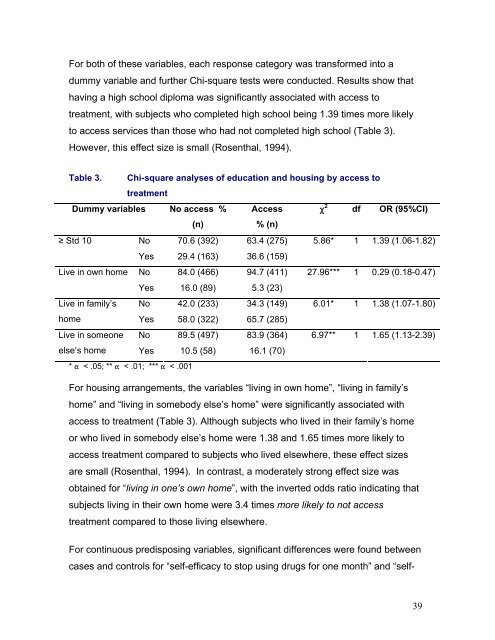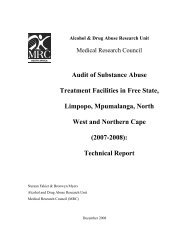Access to substance abuse treatment in the Cape Town metropole ...
Access to substance abuse treatment in the Cape Town metropole ...
Access to substance abuse treatment in the Cape Town metropole ...
You also want an ePaper? Increase the reach of your titles
YUMPU automatically turns print PDFs into web optimized ePapers that Google loves.
For both of <strong>the</strong>se variables, each response category was transformed <strong>in</strong><strong>to</strong> adummy variable and fur<strong>the</strong>r Chi-square tests were conducted. Results show thathav<strong>in</strong>g a high school diploma was significantly associated with access <strong>to</strong><strong>treatment</strong>, with subjects who completed high school be<strong>in</strong>g 1.39 times more likely<strong>to</strong> access services than those who had not completed high school (Table 3).However, this effect size is small (Rosenthal, 1994).Table 3. Chi-square analyses of education and hous<strong>in</strong>g by access <strong>to</strong><strong>treatment</strong>Dummy variables No access % <strong>Access</strong> P 2 df OR (95%CI)(n)% (n)≥ Std 10No 70.6 (392) 63.4 (275) 5.86* 1 1.39 (1.06-1.82)Yes 29.4 (163) 36.6 (159)Live <strong>in</strong> own home No 84.0 (466) 94.7 (411) 27.96*** 1 0.29 (0.18-0.47)Yes 16.0 (89) 5.3 (23)Live <strong>in</strong> family’s No 42.0 (233) 34.3 (149) 6.01* 1 1.38 (1.07-1.80)home Yes 58.0 (322) 65.7 (285)Live <strong>in</strong> someone No 89.5 (497) 83.9 (364) 6.97** 1 1.65 (1.13-2.39)else’s home Yes 10.5 (58) 16.1 (70)* " < .05; ** " < .01; *** " < .001For hous<strong>in</strong>g arrangements, <strong>the</strong> variables “liv<strong>in</strong>g <strong>in</strong> own home”, “liv<strong>in</strong>g <strong>in</strong> family’shome” and “liv<strong>in</strong>g <strong>in</strong> somebody else’s home” were significantly associated withaccess <strong>to</strong> <strong>treatment</strong> (Table 3). Although subjects who lived <strong>in</strong> <strong>the</strong>ir family’s homeor who lived <strong>in</strong> somebody else’s home were 1.38 and 1.65 times more likely <strong>to</strong>access <strong>treatment</strong> compared <strong>to</strong> subjects who lived elsewhere, <strong>the</strong>se effect sizesare small (Rosenthal, 1994). In contrast, a moderately strong effect size wasobta<strong>in</strong>ed for “liv<strong>in</strong>g <strong>in</strong> one’s own home”, with <strong>the</strong> <strong>in</strong>verted odds ratio <strong>in</strong>dicat<strong>in</strong>g thatsubjects liv<strong>in</strong>g <strong>in</strong> <strong>the</strong>ir own home were 3.4 times more likely <strong>to</strong> not access<strong>treatment</strong> compared <strong>to</strong> those liv<strong>in</strong>g elsewhere.For cont<strong>in</strong>uous predispos<strong>in</strong>g variables, significant differences were found betweencases and controls for “self-efficacy <strong>to</strong> s<strong>to</strong>p us<strong>in</strong>g drugs for one month” and “self-39
















